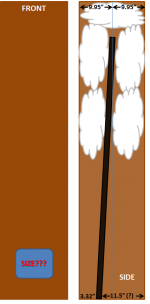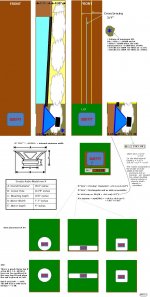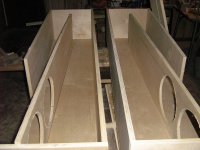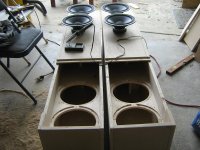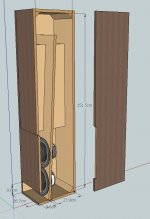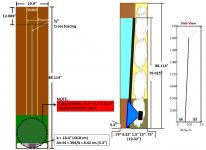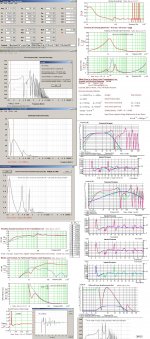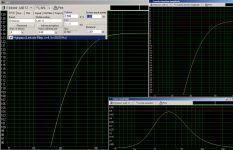bjorno,
The design you propose looks to perform very well. Here are a few question's that I thought of after reviewing the data:
1. How much amplification power will be required - and what is recommended maximum - to drive the sub? From the data it looks like 106 W will drive to 120 dB at 13 Hz (0.5 x Pi). If so, in a normal size room will not need thousands of watts.
2. What is the maximal output before cone excursion is reached using recommended HPF?
2. How big is the opening Alt S4, I cannot find the numbers on the attachment? What effect is there on the performance if the opening is larger? Is "port" noise something of concern with this type of design?
3. What are the nagative trade-offs of the design compared to a TH, ported or sealed design? I have learned nothing comes without a cost. The size of the enclosure is huge, but I think it could placed standing in a rear corner or laying horizontally along the front wall under the projection screen.
Thanks again for your support and expertice! It looks like this will be a beast of a speaker.
The design you propose looks to perform very well. Here are a few question's that I thought of after reviewing the data:
1. How much amplification power will be required - and what is recommended maximum - to drive the sub? From the data it looks like 106 W will drive to 120 dB at 13 Hz (0.5 x Pi). If so, in a normal size room will not need thousands of watts.
2. What is the maximal output before cone excursion is reached using recommended HPF?
2. How big is the opening Alt S4, I cannot find the numbers on the attachment? What effect is there on the performance if the opening is larger? Is "port" noise something of concern with this type of design?
3. What are the nagative trade-offs of the design compared to a TH, ported or sealed design? I have learned nothing comes without a cost. The size of the enclosure is huge, but I think it could placed standing in a rear corner or laying horizontally along the front wall under the projection screen.
Thanks again for your support and expertice! It looks like this will be a beast of a speaker.
Define 'best' because when I 'run the numbers' for a TH I get a very low tuned ~7 Hz DTS concept that requires a big amp to take full advantage of this house wrecker's high power handling capability for movie LFE and pipe organ symphonies at ~live levels:
GM
edit: corrected upload file
GM,
I am looking for a sub to cover below my four sealed LAB12 subs (120 dB output down to 60 Hz, -3 dB at 45 Hz [WinISD numbers]). I want clean output up to reference levels. I ran hornresp on the parameters and they looked good, but I have no skill at folding a horn and the build will be strictly DIY. Folded TH's look very difficult to build correctly without having a CNC cut the material - all the angles to get good seals seem to be beyond my limited power tool capabilities (circular saw, router, and drill).
Thank you for your input!
Trying to put the design submitted by bjorno into a scale drawing so i can develop plans (see attached). Still cannot find on the MJK spreadsheet the size of the front opening (alt S4). I also just guessed on where the 4.407 lbs of stuffing should go. I assume this is polyfill, but would something like R19 isulation also work?
Thanks
Thanks
Attachments
Trying to put the design submitted by bjorno into a scale drawing so i can develop plans (see attached). Still cannot find on the MJK spreadsheet the size of the front opening (alt S4). I also just guessed on where the 4.407 lbs of stuffing should go. I assume this is polyfill, but would something like R19 isulation also work?
Thanks
Hi,
It's polyfill. I'm quite busy for the moment..I will later reply to your post #21...but here is a picture that may clarify a bit:
b
Attachments
Hi,
It's polyfill. I'm quite busy for the moment..I will later reply to your post #21...but here is a picture that may clarify a bit:
b
I am not in any particular rush, I am in Cambodia and the driver is the US. I am thrilled that you have been willing to spend the time to develop an appropriate enclosure for the driver.
The picture does clarify, looks like the build should not be terribly difficult.
I am not in any particular rush, I am in Cambodia and the driver is the US. I am thrilled that you have been willing to spend the time to develop an appropriate enclosure for the driver.
The picture does clarify, looks like the build should not be terribly difficult.
Yeah, it looks a lot like the one I did with B's help, I'll attach a few pics for visualization. Of course, yours will be larger with the larger driver.
Attachments
Yeah, it looks a lot like the one I did with B's help, I'll attach a few pics for visualization. Of course, yours will be larger with the larger driver.
Thanks for the pictures, it definately helps me to visualize what this design will look like. I am planning on placing the sub either standing in a rear corner or horizontal across the front soundstage.
Hi,
It's polyfill. I'm quite busy for the moment..I will later reply to your post #21...but here is a picture that may clarify a bit:
b
bjorno,
Spent a lot of time studying the picture - it contains info that answered a lot of my questions, thank you so much!!!
Based on the MJK data you provided earlier, the speaker will be 19.9" Wide x 88.114" Tall x 19.32" Deep. With these dimensions, the internal width of the fron will be 18.4", which is the diameter of the driver. Is this okay?
I have made a crude drawing of what I think are the correct dimensions, if they are right I will try to draw out a cut sheet for the project later this week.
Based on your calculations, this sub will be able to play insanely loud at very low frequencies.
Attachments
Last edited:
GM,
Folded TH's look very difficult to build correctly without having a CNC cut the material - all the angles to get good seals seem to be beyond my limited power tool capabilities (circular saw, router, and drill).
Thank you for your input!
A circular saw (if you don't/can't have a table saw), DIY saw guide, drill, router and clamps are really all you need to build most enclosures, horns included.
PL polyurethane glue (expands as it cures) helps fill in any slight gaps in internal horn construction
I just modeled the mother of all LLT BR designs for this driver. You can't get the full potential out of this driver with a BR box. Sealed would be the only other way to do it... and it would be a 16ft^3 box.
"this sub will be able to play insanely loud at very low frequencies."
Yes it will!!!
"this sub will be able to play insanely loud at very low frequencies."
Yes it will!!!
Ok, I just modeled another Vent in SolidWorks that would work but it's so complex you'd need a CNC Lathe.
That and you'd get about the same output as the T-TQWP and the group delay would be worse.
you're in good hands.
Yeah, when I came around looking for ideas for my drivers (older peerless 10s), I'd had them in lots of cabinets over the years. 25" br cubes, triangular corner loader br (which I still have) and some pretty large 4 foot x 2 foot x 2 foot "bipolars" with drivers on the side and front, but when B gave me the dimensions for these tubes and I built them, my jaw has pretty much been on the floor.
Even at low volumes, they dig down so well, I've been on the prowl for music with great bass and they continue to impress me. Fan for life!
..Based on the MJK data you provided earlier, the speaker will be 19.9" Wide x 88.114" Tall x 19.32" Deep. With these dimensions, the internal width of the fron will be 18.4", which is the diameter of the driver. Is this okay?..I have made a crude drawing of what I think are the correct dimensions, if they are right I will try to draw out a cut sheet for the project later this week..
Hi,
Your drawing looks OK and you're right: The internal width is minimum 18.4" rounded up to 46.8 cm. In reality you may be off an 1/2" on any dimension as a T-TQWT like an TL can easily be compensated to correct tuning using the amount and density of the damping material.
Referring post# 21 :
1.IMO, Any power-amp above ¨200-300W would be sufficient for sane SPL in typical home environments as this speaker is displacement limited, not by power but if equipped with a 12 Hz Bw4 HPF/ 50 Hz LR4 LPF the maximum available Power would be around 1450W into 4 Ohm at x-mech.
2. S4 is 394 cm^2 and is sufficiently large but may be enlarged to Sd/2 if ~1-2dB drop in SPL and a few Hz lesser BW are allowed at the lowest in-band end of the FR.
3. I think the sturdiness of the sub box and/or the room soundproofing set the SPL limit not the eventual heard "port" noise.
4. I cant find negative trade-offs when I choose to design a T-TQWT compared to a closed/ported or TH enclosure for a specific driver, do you?
Supplementing the earlier pictures using max power as the input level:
b
Attachments
Thank you everyone for contributing to this thread, before starting it I did an extensive search and could not really find a lot of information.
I cannot see any negatives in going with this design to supplement my sealed LAB-12 subs. As I have indicated I am looking for performance only below 40 - 50 Hz.
I will be working on a cutsheet over the weekend.
Thanks again to all those sharing insight, expertice and experience.
I cannot see any negatives in going with this design to supplement my sealed LAB-12 subs. As I have indicated I am looking for performance only below 40 - 50 Hz.
I will be working on a cutsheet over the weekend.
Thanks again to all those sharing insight, expertice and experience.
A circular saw (if you don't/can't have a table saw), DIY saw guide, drill, router and clamps are really all you need to build most enclosures, horns included.
PL polyurethane glue (expands as it cures) helps fill in any slight gaps in internal horn construction
Not really, I had been building horn, etc. speakers for years before I had any power tools, though admittedly the hand tools I had were top grade owned by a master furniture maker and antebellum house restorer; and didn't buy a router or table saw till ~ a decade after my peak building years..................
Yeah, I was an early adopter of PL400 for bonding most everything made from wood since I didn't need to use nearly as many screws or nails to clamp it, just kind of 'floated' the joints with just picture frame clamps on the corners to keep it squared up.
GM
I have attached the WinISD modeling data for the 4 LAB-12 subs I will be using with this build. The calculation is -3 dB down at 44.39 Hz (121 dB). Calculations are based on maximum power that does not exceed cone excursion with an HPF (20 Hz, 4th order LR).
Based on bjorno's data the Mal-X sub will extend usable frequency response to below 13 Hz.
I believe a distributed bass system that models flat between 13 and 100 Hz at over 120 dB will be more than enough bass for my needs. My current setup while stationed overseas in Cambodia has 2 of the LAB-12 subs and an old Paradigm PDR12 and really sounds pretty good (no measured response less than 20 Hz in the room).
Based on bjorno's data the Mal-X sub will extend usable frequency response to below 13 Hz.
I believe a distributed bass system that models flat between 13 and 100 Hz at over 120 dB will be more than enough bass for my needs. My current setup while stationed overseas in Cambodia has 2 of the LAB-12 subs and an old Paradigm PDR12 and really sounds pretty good (no measured response less than 20 Hz in the room).
Attachments
...when B gave me the dimensions for these tubes and I built them, my jaw has pretty much been on the floor.
Even at low volumes, they dig down so well, I've been on the prowl for music with great bass and they continue to impress me. Fan for life!
Awesome! I cannot wait to be able to build B's latest creation. Perhaps I should start calling them the Killer B's.
Awesome! I cannot wait to be able to build B's latest creation. Perhaps I should start calling them the Killer B's.
Haha, nice. I noticed with mine (I don't have any measurement tools yet, so I can't be certain) but when I first made them I sat them up right next to my mains pulled out into the room away from the walls and the response seemed to be just about what you're looking to have them cover, I.E they seemed to cover from about 20hz up to 40-ish.
A good music example is the track "Grandaddy - He's simple, he's dumb, he's the pilot". At about 4:45 into the song, a slow moving bass line starts. With the subs out in the room, the only note I could hear them produce was the lowest note in this bass line. While I was laughing, my room mate was quick to quip "So....really, they're earthquake generators...not subs?"
I use them as my only sub so I ended up settling on them wedged in the corners which seemed to flatten them back out all the way up to 80hz. Maybe having it out of the corners in the room will give you the response you need without too much crossover or eq tweaking. I know there's a relationship with pi space as it relates to the response you'll get, but I'm not sure what the actual effect is or how to explain it with a chart, but wall positioning plays a big, big role in the response these have.
4. I cant find negative trade-offs when I choose to design a T-TQWT compared to a closed/ported or TH enclosure for a specific driver, do you?
Hello Bjorno, or anyone else who wants to discuss.
I do not have hands on experience with one of these designs yet but they seem to be quite popular on this forum so I am interested in why. From looking at quite a few simulations I would list very limited bandwidth as issue #1. Also sensitivity seems to be lower than an equivalent sized TH. Response in the time domain appears to be much worse than a sealed or ported alignment same as with a TH or FLH. Ringing abounds anywhere other than over the almost 2 octave wide bandwidth where the alignment is most effective. In this case maybe 16-60Hz.
Since this seems to be essentially a reverse TH with many shared characteristics. I suspect that the distortion and compression might trend the same in general ways. That is to say that the distortion will be very low in some areas typically below the 5th harmonic of a TH it will be very low in THD which would mean the same for these and at the 5th and above THD is much higher and wildly varying with frequency and power above that point. Of course the TQWP is completely unuseable much above that point anyway, but a TH can potentially be beaten into submission with EQ, damping and perhaps internal pipe resonance cancellation (DTS-20) enough to work, ok. Potentially the THD might possibly be even lower for a TQWP over the useful bandwidth due to the cancellation effects of the enclosure on frequencies corresponding to the harmonics.
Are their any in depth investigative measurements of a TQWP that someone can point me to?
A basic 320L total volume, 20Hz tuned vented alignment utilizing a vent of 365cm (Equivalent to 2 6" flared ports) seems to have just as much sensitivity and maximum output as the TQWP presented here over it's useful bandwidth. In addition the vented alignment will have better response in the time domain and could potentially be used up till 150Hz or higher if needed.
The TQWP seems quite similar in operation to a 6th or even 4th order BP. What are it's advantages against them?
- Status
- This old topic is closed. If you want to reopen this topic, contact a moderator using the "Report Post" button.
- Home
- Loudspeakers
- Subwoofers
- TH or T-TQWP or ????
